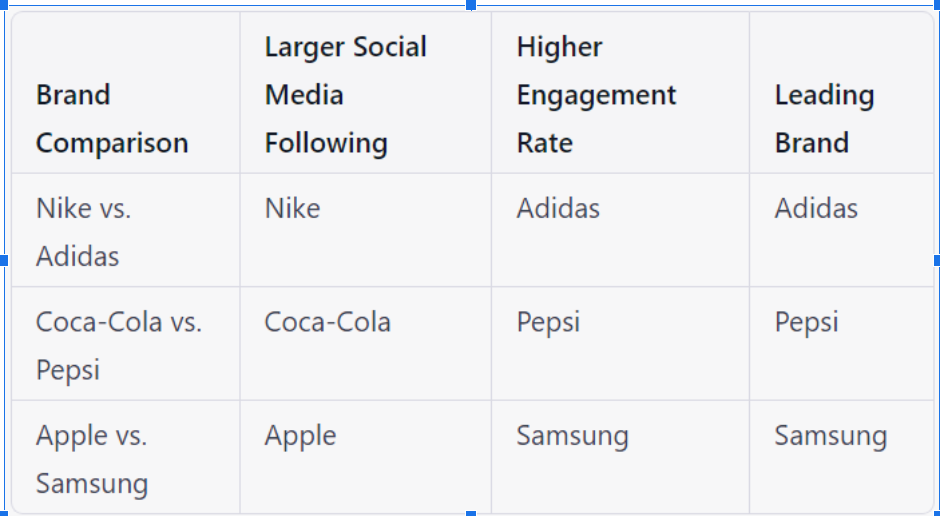
evalmyBRAND | Social Listening Blog Post

Social media is an ever-changing landscape, and it’s critical for brands to stay on top of what their competitors are doing on these platforms. Conducting competitor analysis on social media is an essential part of any social media strategy. It allows brands to gain insights into their competitors’ tactics, identify opportunities, and stay ahead of the competition.
In this blog post, we’ll explore how you can conduct competitor analysis on social media like a pro, and how the evalmyBRAND social listening platform can help you power your brand insights with competitor analysis.
Competitive analysis on social media involves examining the social media performance of a brand’s competitors to gain insights into their strengths, weaknesses, and strategies. The following are some ways in which the metrics mentioned earlier can be used to study competitors:

The first step to conducting a competitor analysis on social media is to identify who your competitors are. This may seem obvious, but it’s crucial to get this step right. You don’t want to waste your time analyzing the wrong accounts or brands that aren’t directly competing with you.
Begin by researching the brands in your industry and look for those that are active on social media. Make a list of the brands that are posting frequently, generating a lot of engagement, and targeting the same audience as you.

Once you’ve identified your competitors, the next step is to monitor their social media activity. You can do this manually by following their social media profiles and taking note of their posts, engagements, and overall performance. However, this method can be time-consuming and may not provide you with a comprehensive view of your competitors’ social media strategy.
This is where the evalmyBRAND social listening platform comes in. The platform allows you to track your competitors’ social media activities in real-time, including their posts, engagements, and sentiment. This provides you with a comprehensive view of your competitors’ social media performance, and you can quickly identify areas where you can improve your own social media strategy.

Once you’ve monitored your competitors’ social media activity, the next step is to analyze their content strategy. This involves looking at the types of content they post, the frequency of their posts, and the engagement they receive. You can use this information to identify content gaps in your own social media strategy and to improve the quality and relevance of your content.
The evalmyBRAND platform provides you with detailed insights into your competitors’ content strategy, including the topics they cover, the formats they use, and the engagement they receive. This allows you to tailor your content strategy to better match your competitors and to stand out in a crowded social media landscape.

Engagement is a key metric in social media marketing, as it indicates how well your content is resonating with your audience. Tracking your competitors’ engagement can help you identify the types of content that are most effective at driving engagement and to replicate these strategies in your own social media marketing.
The evalmyBRAND platform allows you to track your competitors’ engagement on social media, including likes, comments, and shares. This provides you with a detailed view of their audience engagement and allows you to identify areas where you can improve your own engagement strategy.

Finally, it’s essential to measure your own social media performance against your competitors. This allows you to identify areas where you are outperforming your competitors and areas where you need to improve.
The evalmyBRAND platform provides you with comprehensive performance metrics, allowing you to track your social media performance against your competitors. This includes metrics such as reach, engagement, and sentiment, providing you with a detailed view of your social media performance.
Conducting competitor analysis on social media is crucial for any brand looking to gain a competitive advantage in today’s
Quick Stats:
Example: Brand Comparison of some leading brands of different domains:

As you can see from these examples, conducting competitor analysis on social media can provide valuable insights into your competitors’ social media strategies and help you identify opportunities to improve your own social media performance. With the help of a social listening platform like evalmyBRAND, you can power your brand insights with competitor analysis and stay ahead of the competition.

Amplify Your Product Brand’s Success on Instagram with Social Listening and evalmyBRAND Amplify Your Product Brand’s Success on Instagram with Social Listening and evalmyBRAND Amplify

The Power of Social Listening: Unveiling the Secrets to a Successful Content Strategy Facebook Twitter LinkedIn Crafting an effective content strategy is paramount in today’s

8 Effective Methods for Market Research Using Social Listening Facebook Twitter LinkedIn In the ever-evolving digital world, businesses now have vast access to customer data